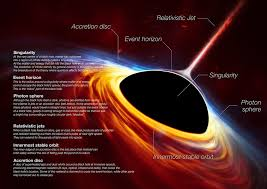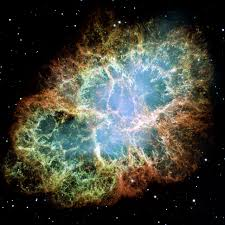What is black hole ?
A black hole is a region in the space where gravity is too strong to let anything- even light-out of that region. This tremendous gravity is due to a large concentration of mass in an area that is extremely small in size. Black holes have always been interesting objects that probe our understanding of physics and about the universe. Here's an overview
 |
| first & real image of blackhole Cygnus X-1, |
Details of the EHT's Black Hole Image:
1. Black Hole Observed:
- The picture is that of a supermassive black hole located at the heart of galaxy Messier 87, or M87
- .The distance from Earth is around 55 million light-years.This black hole is estimated to be equivalent to about 6.5 billion Suns.
2.What Was Captured:
- This is a picture showing a dark center, a shadow of the black hole, surrounded by a bright ring of light.
- The bright ring refers to the glowing gas and dust in the accretion disk, heated to extreme temperatures as it spirals into the black hole.
- The shadow refers to the event horizon, which marks the boundary beyond which nothing, including light, can escape.
3.How the EHT Worked:
- The EHT used data from eight radio telescopes distributed across different locations such as the United States, Chile, Antarctica, Spain, and Hawaii.
- Atomic clocks used for synchronization helped them attain an angular resolution good enough to observe structures of sizes comparable to the event horizon.
4.Importance
- It was the first-ever direct visual evidence of a black hole's existence and, thereby confirmed theoretical predictions of Einstein's theory of general relativity.
Black Hole Types:
1.Stellar Black Holes:
Results from massive stars that have burned their nuclear fuel, collapsed in on themselves, due to their own gravity.
Tend to be between 5 and 20 solar masses
2.Supermassive Black Holes:
Situations at the heart of galaxies, including the Milky Way (e.g. Sagittarius A*).
Billions to billions of solar masses
Possibly from merging smaller black holes, plus accumulation of matter over billions of years.
3.Intermediate Black Holes:
Believed to range in size from stellar to supermassive black holes.
Uncommon and not thoroughly known.
4.Primordial Black Holes:
These would be hypothetical black holes that potentially arose a few minutes after the Big Bang.
They would, depending on conditions at time of formation, vary from quite tiny to large in mass.
- Region of blackhole
| Part | Location | Key Features |
|---|---|---|
| 1.Singularity | Center | Infinite density; core of the black hole. |
| 2.Event Horizon | Surrounds the singularity | Point of no return for anything falling in. |
| 3.Accretion Disk | Outside the event horizon | Emits radiation from heated infalling matter. |
| 4.Photon Sphere | Outside the event horizon | Light orbits in unstable circular paths. |
| 5.Relativistic Jets | Poles of black hole (not always present) | Ejected streams of particles. |
| 6.Ergosphere | Surrounds the event horizon (rotating black holes) | Frame-dragging effects. |
| 7.Shadow | Apparent size seen from afar | Larger than the event horizon due to light bending. |
1.Singularity
Definition:
The singularity is the point at the center of the black hole where its mass is collected.
Properties
:
Infinite density and zero volume, at least according to general relativityHere, the laws of physics that we know today collapse.There is an infinite strength gravitational force.
2. Event Horizon
Definition:
The event horizon is the boundary surrounding the black hole, marking the point of no return.
Properties
- Nothing, not even light can cross this boundary and return.
- Its size is known as the Schwarzschild radius (for non-rotating black holes).
- The event horizon size depends on the mass of the black hole
.
3. Accretion Disk
Description:
A disk of gas, dust, and other material that orbits the black hole in a swirling motion before plunging into it.
Characteristics:
The material in the disk gets hot from friction and radiates very intense radiation, frequently X-rays.
The accretion disk is among the brightest features of an active black hole.
4. Photon Sphere
Explanation:
Area in which the light can orbit around the black hole in a circular fashion.
Characteristics:
- Located outside the event horizon by just a thin margin.
- Highly unstable: photons within this sphere either fall into the black hole or move off to infinity.
5. Relativistic Jets
Explanation:
A highly energetic flows of charged particles that have been thrown out from the poles of some black holes.
Characteristics:
- They are caused by the intense magnetic fields created within the accretion disk.
- Can reach thousands or even millions of light-years into space.
- Very common in supermassive black holes at the centers of active galaxies (e.g., quasars).
6. Ergosphere (Rotating Black Holes Only)
Definition:
A region outside the event horizon of a rotating (Kerr) black hole.
Features
:
Space and time are dragged along with the black hole's rotation, a phenomenon known as frame-dragging.
In this region, objects cannot be at rest relative to distant observers.
Energy can be extracted from this region through the Penrose process.
7. Shadow
Description:
This is the dark silhouette of the black hole against a bright background of its surrounding.
Characteristics:
First images of the first black hole (such as M87*) were identified by the Event Horizon Telescope
The shadow is a little bigger than the event horizon due to the bending of light around a black hole.
How Do Black Holes Form?
Stellar Collapse:
When a massive star exhausts its nuclear fuel, its core collapses under gravity, which can form a black hole.
Mergers:
Smaller black holes can merge to create larger ones.
Accretion:
A black hole grows by pulling in gas, dust, stars, or other black holes.







0 Comments